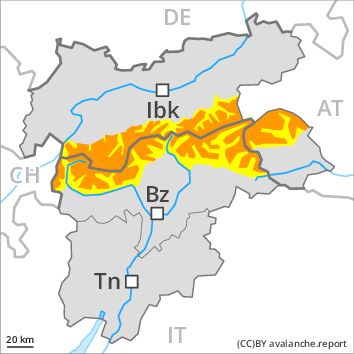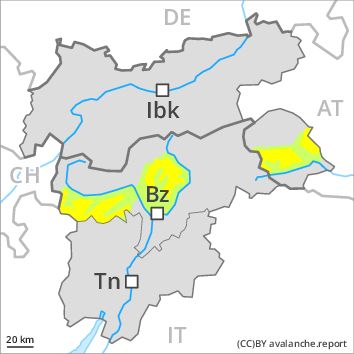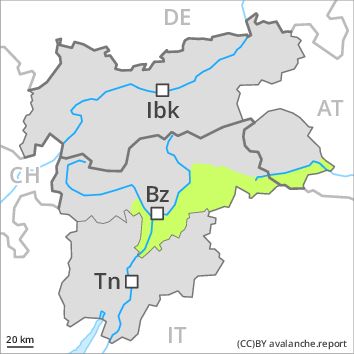Regions
Eastern Pfunderer Mountains, Durreck Range, Weißkugel Range, Western Rieserferner Mountains, Val Müstair Alps, Gurgler Range, Western Deferegger Alps, Langtaufers, Central Stubai Alps, Schnals Ridge, Northern Zillertal Alps, Southern Stubai Alps, Venediger Range, Southern Zillertal Alps and High Tauern, Eastern Rieserferner Mountains, Saldurn-Mastaun Ridge, Glockner Range, Texel Mountains, Western Pfunderer Mountains, Glockturm Range

Danger level
Danger Level 3 - Considerable above the treeline
Danger Level 2 - Moderate above the treeline
Avalanche Problem
Wind-drifted snow above the treeline, N-NE-E-SE-S-SW-W-NW

Backcountry touring calls for caution and restraint.
As a consequence of fresh snow and a strong to storm force wind, sometimes large wind slabs formed. They are in some cases prone to triggering. They can be released even by a single winter sport participant in all aspects. This applies in particular at their margins. In particular at the base of rock walls more medium-sized dry slab avalanches are possible. Mostly the avalanches are medium-sized. In regions with a lot of snow avalanche prone locations are more prevalent and the danger is greater. The avalanche prone locations are barely recognisable because of the poor visibility. Backcountry touring calls for caution and restraint.
Distinct weak layers in the old snowpack can be released in isolated cases. This applies in particular in areas where the snow cover is rather shallow. The avalanche situation is a little more favourable in highly frequented off-piste terrain.
Snowpack
dp 6: cold, loose snow and wind
Over a wide area 15 to 30 cm of snow. fell. As a consequence of fresh snow and a strong to storm force wind, sometimes large wind slabs formed. In some cases the various wind slabs have bonded still only poorly with each other and the old snowpack. Faceted weak layers exist in the old snowpack. The old snowpack will be in some cases prone to triggering.
Tendency
Hardly any decrease in avalanche danger.
Regions
Eastern Deferegger Alps, Sarntal Alps, Schober Mountains, Ortler Range, Ulten Valley

Danger level
Danger Level 2 - Moderate above the treeline
Danger Level 1 - Low above the treeline
Avalanche Problem
Wind-drifted snow above the treeline, N-NE-E-SE-S-SW-W-NW

Fresh wind slabs require caution.
As a consequence of fresh snow and a strong wind, wind slabs formed over a wide area. The wind slabs are in isolated cases prone to triggering. The avalanche prone locations are to be found in all aspects, especially in gullies and bowls, and behind abrupt changes in the terrain. Avalanches can be released in the old snowpack especially at transitions from a shallow to a deep snowpack. The avalanche prone locations are barely recognisable because of the poor visibility. In steep terrain there is a danger of falling on the hard snow surface.
Snowpack
dp 6: cold, loose snow and wind
In some regions up to 5 cm of snow, and even more in some localities, fell. In some places fresh snow and wind slabs are lying on soft layers. The snowpack will be subject to considerable local variations. Individual weak layers exist deep in the snowpack on shady slopes.
Tendency
Hardly any increase in avalanche danger.
Regions
Gröden Dolomites, Prags Dolomites, Lienzer Dolomites, Sexten Dolomites, Eastern Nonsberger Alps, Northern Dolomites of Fiemme

Danger level
Danger Level 1 - Low
Avalanche Problem
Wind-drifted snow above the treeline, N-NE-E-SE-S-SW-W-NW

The snowpack will be generally well bonded.
The sometimes strong wind has transported only a little snow. The no longer entirely fresh wind slabs have bonded quite well with the old snowpack. These can only be released by large loads in most cases. The avalanche prone locations are to be found on steep slopes of all aspects, especially in gullies and bowls, and behind abrupt changes in the terrain. These places are clearly recognisable to the trained eye.
In steep terrain there is a danger of falling on the icy crust.
Snowpack
Little snow has fallen. The fresh and somewhat older wind slabs are mostly small and can only be released in isolated cases. In some cases relatively hard layers of snow are lying on old snow containing large grains. Individual weak layers exist deep in the snowpack on shady slopes. The snowpack will be subject to considerable local variations. On south and southwest facing slopes a little snow is lying in all altitude zones.
Tendency
Increase in danger as a consequence of the fresh snow.



